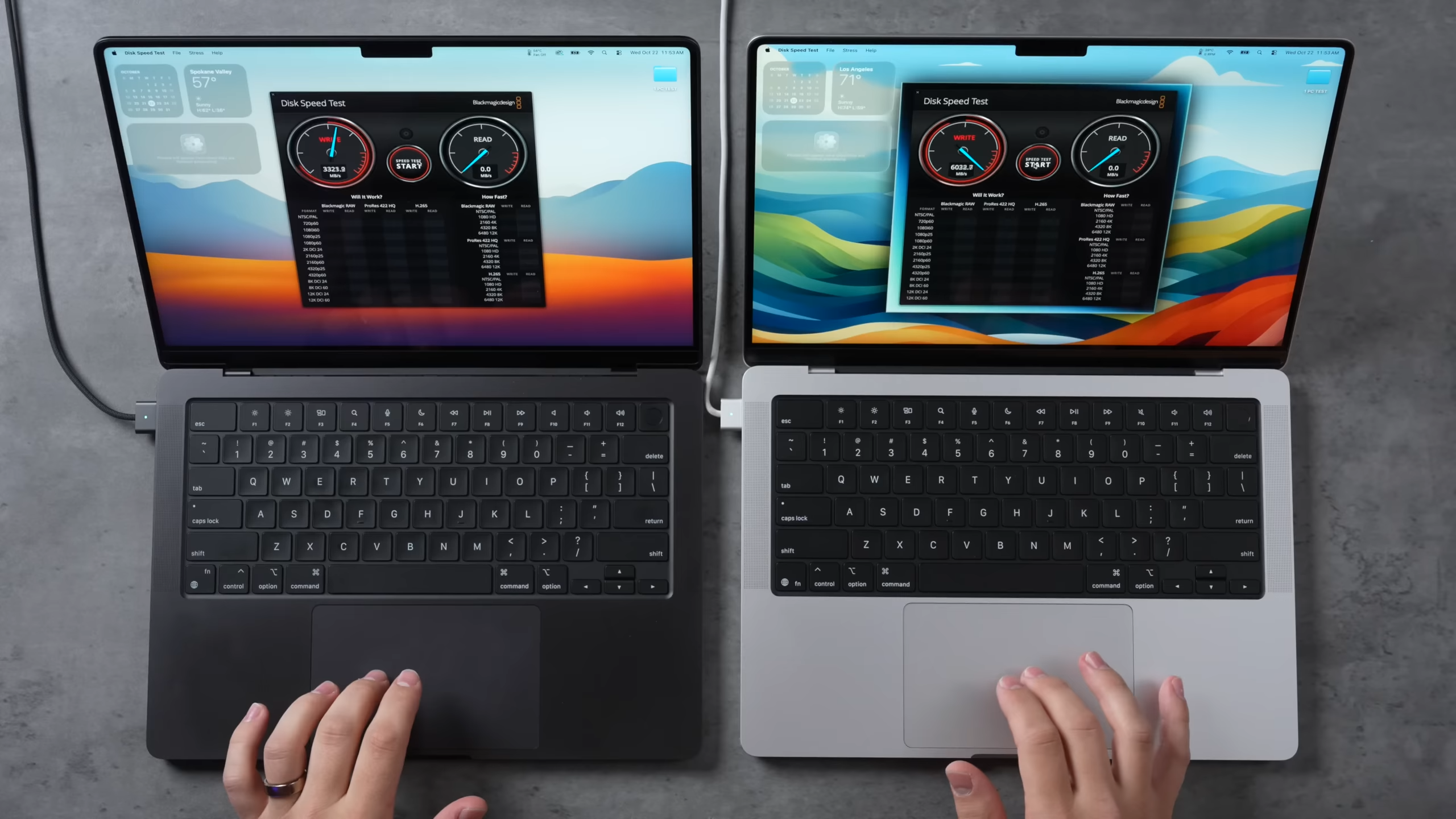M5 MacBook Pro's SSD is 2.5x faster on average than last-gen M4, exceeding Apple's own claims — M5 achieves 6,000+ MB/s across both read and write speeds

When Apple unveiled the 2025 MacBook Pro last week with the new M5 chip, one of the main upgrades it listed was 2x SSD speeds, a claim that rings true in our review of the device. However, a directed comparison between the outgoing M4-equipped MacBook Bro and the new M5 one was still on the cards, and now, we've gotten just that. YouTuber Max Tech put both laptops head-to-head to see whether Apple's claims were true, and it turns out, the company may have actually undersold the new machine's SSD speeds.
In the Blackmagic Disk Speed Test, the SSD in the M5 MacBook Pro achieved read speeds of up to 6,323 MB/s, compared to just 2,031 MB/s on the M4 MacBook Pro. It's not like the M4 is "slow" in a vacuum, but the M5 SSD is over three times faster, which is a great generation uplift. Moving to the write speeds, the trend continues but less aggressively, with the M5's SSD reaching a similar 6,068 MB/s while the M4's SSD could only manage 3,293 MB/s, constituting an 84.31% difference. If you average out both results, the SSD in the M5 MacBook Pro is actually ~2.5x faster overall.
Speeds | M5 MacBook Pro (2025) | M4 MacBook Pro (2024) | Difference |
|---|---|---|---|
Read | 6,323 MB/s | 2,031 MB/s | +211.13% |
Write | 6,068 MB/s | 3,293 MB/s | +84.31% |
These speed improvements could be a result of a better controller allowing the flash to run faster, since PCIe Gen4 NVMe SSDs on PCs can achieve similar numbers. Apple routes 4x PCIe lanes to the SSD on its base chips, but doubles that to 8x on the Pro/Max/Ultra variants of the same silicon. Nonetheless, 6K+ MB/s across both read and write means smoother video editing for professionals that can benefit them in edge-case scenarios, not that it felt particularly slow before. You can also expect better random read/write speeds that should make the OS feel snappier in general.
Max Tech opened up both devices before performing the test to show the internal layout, which was identical. They share the same cooling systems with a single fan and a single heatpipe, along with two NAND modules (256 GB each) to ensure optimal performance. The base variant of the M2 Pro MacBook Pro from 2023 was stained with controversy because of this, when Apple decided to use a single 512 GB NAND chip, which crippled storage speeds drastically, so it's nice to see such a massive turnaround a couple of years later.

Follow Tom's Hardware on Google News, or add us as a preferred source, to get our latest news, analysis, & reviews in your feeds.
Get Tom's Hardware's best news and in-depth reviews, straight to your inbox.

Hassam Nasir is a die-hard hardware enthusiast with years of experience as a tech editor and writer, focusing on detailed CPU comparisons and general hardware news. When he’s not working, you’ll find him bending tubes for his ever-evolving custom water-loop gaming rig or benchmarking the latest CPUs and GPUs just for fun.
-
heffeque Hassam seems to have problems with proofreading.Reply
He also has errors on the table here:
https://www.tomshardware.com/pc-components/cpus/gaming-optimized-ryzen-5-7500x3d-spotted-at-uk-retailer-new-six-core-budget-cpu-apparently-readied-for-launch-amd-might-be-prepping-the-cheapest-zen-4-based-3d-v-cache-chip-to-date ...
Which hasn't been corrected yet. -
Giroro The Blackmagic benchmark is beyond moot when the entire SSD has less capacity than the $50 micro SD card you probably have in your cheapest camera.Reply
Macs are the absolute worst computers at video editing, because the #1 and #2 specs you need are storage capacity and RAM. So Apple makes you spend close to $6,000 just to load projects that can be edited on a <$1,000 PC -
magbarn Reply
At least they're giving you more bang for buck! They're still charging you SSD prices from 10 years ago however... The soldered SSDs are already bricking the macbooks from 6-7 years ago so it does limit the machine's lifetime unless you're willing to do delicate soldering...LordVile said:So the drives that were already too fast to notice are faster? -
Giroro Replyheffeque said:Hassam seems to have problems with proofreading.
He also has errors on the table here:
https://www.tomshardware.com/pc-components/cpus/gaming-optimized-ryzen-5-7500x3d-spotted-at-uk-retailer-new-six-core-budget-cpu-apparently-readied-for-launch-amd-might-be-prepping-the-cheapest-zen-4-based-3d-v-cache-chip-to-date ...
Which hasn't been corrected yet.
You're absolutely right about the table—AMD Ryzen 7000X3D has not yet been created, but it is an interesting idea which AMD may release in the future. Here's the corrected table you wanted.
Please let me know if there is anything else I can help you with.
AMD Ryzen 5000X3D lineupSKUCPU Cores/Threads (Zen 4)Combined cache (L2 + L3 + X3D)Boost Clock SpeedsTDPSuggested PricingRyzen 9 5950X3D16C/32T144 MB5.7 GHz120W$699Ryzen 9 5900X3D12C/24T140 MB5.6 GHz120W$599Ryzen 7 5800X3D8C/16T104 MB5.0 GHz120W$449Ryzen 5 5600X3D6C/12T102 MB4.7 GHz65W$299Ryzen 5 5500X3D6C/12T102 MB>4.7 GHz (speculative)65W>$299 (speculative) -
drtweak And watch them say "Look at this new tech!" while I am over here with my 12G a second 2TB NVMe in my 2 year old PC lolReply
